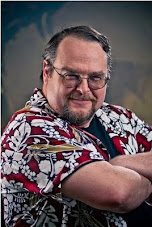So a week back I got a chance to watch one of my favorite movies - "The Thin Man". (There's a difference between "favorite movies" and "great films", but that's a blog for another day). And as a result, I found an old copy of Dashiell Hammett's The Thin Man on the shelf and read it through, which I don't think I had done before.
Here are the facts of the matter - the book, by Dashiell Hammett, was set in New York of 1932, just before Prohibition ended, but published in January of 1934 (Alfred A. Knopf, but I had a Permabook reprint edition published in March of 1961). The movie was adapted by Frances Goodrich and Albert Hackett, was filmed in two weeks, and was released in May of the same year, just before enactment of the Hollywood Production Codes, and was a surprise hit. Nick and Nora Charles are supposedly based on the relationship of Hammett and Lillian Hellman, and the adaptors Goodrich and Hackett were a married couple as well. And in the movie we have William Powell and Myrna Loy in the roles.
Now if you haven't seen the movie, you really need to. It is the first and the best of the series, and it's a movie that holds up even when you know the nature of the mystery as well. I was looking at the differences between book and film, and there are many. The story in the novel is told first person by Nick and we meet him on page one. The movie sets up most of the other characters, including the "Thin Man" - Clyde Wynant, and only introduces Nick and Nora well into the film (Powell makes his appearance in a high-class speak, instructing the bartenders in the correct methods of using a cocktail shaker, in a moment establishing Nick Charles as high-class, intelligent, and a lush).
And both book and movie involves Olympics-level ingestion of alcohol - I got to Chapter 15 in the book before I hit a chapter where someone wasn't drinking, and then only because that chapter took place for the most part in a police station. And the main characters and the general plot are pretty much the same, but the minor characters and a lot of the details move around - Mr Jorgensen has a darker secret in the original text, and the book lacks the high-tech detection and the gather-the-suspects at the dinner party. What does stay is a lot of Hammett's banter, which works its way in other characters mouths or in different scenes, but kept the relationship solid.
But then there's the bit about the cannibalism.
OK, in both book and movie, the younger son of Clyde Wynnet is named Gilbert, and is a bookworm with a macabre fascination about the criminal mind. In the movie he's pure poindexter - hair split down the middle, thin rimmed glasses, and placed mostly for laughs. He's a little more sympathetic, but still has the fascination with death. So Charles pulls down a volume from the shelf, and has the boy read a section about Alfred Packer, who may or may not have killed and eaten his companions in the Rockies in 1873. and Hammett reports this article to us in full.
And then the plot resumes and everyone goes on, and no mention of it was ever made again, and I'm left asking - what was THAT all about? Was it a ghost of an earlier draft, one where cannibalism would be a result? Was it foreshadowing for the fact that a character' body is cut up later in the book? Or is it just a bit of wordage that Hammett thought was well-written and hadn't been paid for and hey, if fills out the chapter, so why not put it in? Is it to push a boundary, to charge it up a little?
I mean, Hammett is writing about the New York he knows, so there are references to places and performances that are going on at the end of '32 (both book and movie are set over Christmas, but are light on the entire celebration of the holiday). And there is an Oscar Levant in-joke that I got on the first bounce. But there is a reference to a book, The Grand Manner, which I have no clue on, and then this long section about cannibalism.
This is one of those things that bothers me as a writer. Just so you know.
More later,
My Newest Publication: DARK TOWER
-
*So, *
So, one of the things I saw at GaryCon that interested me greatly was the
new expanded edition of *DARK TOWER*, by the late great Jennnell Jaquay...
12 hours ago


